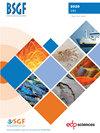法国中部地块Limagne地堑渐新世/中新世边界周围的环境变化
IF 2.6
3区 地球科学
Q2 GEOSCIENCES, MULTIDISCIPLINARY
引用次数: 2
摘要
大陆环境对气候变化非常敏感。法国Limagne地堑盆地为研究渐新世/中新世边界附近的气候变化提供了一个独特的机会,该阶段边界受到化石的很好约束。事实上,利马格尼地堑盆地的一些地方有丰富的哺乳动物遗骸,它们已经成为欧洲哺乳动物生物地层学的参考。利马格尼断陷盆地北部湖相沉积的主要沉积相为胶结不良的泥灰岩和泥灰岩,其中含有与叠层石相关的各种动植物遗骸(如藻类、鱼骨齿、腹足类、介形虫、哺乳动物、鸟类和爬行动物遗骸)。通过新的碳氧同位素测量、孢粉学和沉积学数据,研究人员利用该地区文献中描述的哺乳动物遗骸来约束该湖盆的年代地层背景。在这项工作中,从经典的古生态学研究中获得的可用信息已经通过从冲刷沉积物残留物中提取的碳酸盐和鱼牙的新的碳和氧同位素分析得到了改进。本研究结果证实,渐新世/中新世边界是一个普遍的干旱时期,与较冷的气候有关,这可能是该时期观察到的哺乳动物古多样性下降的原因。介形类和腹足类的出现以及球蝇的主要发育表明了从咸淡水到淡水的逐渐演变。这一时期与潮湿的气候条件有关,而整个阿基坦尼亚期后半段的温度逐渐升高。这些环境变化是由强烈的温度变化和对比的季节性驱动的。本文章由计算机程序翻译,如有差异,请以英文原文为准。
Environmental changes around the Oligocene/Miocene boundary in the Limagne graben, Massif Central, France
Continental environments are very sensitive to climatic variations. A unique opportunity to study the climate changes around the Oligocene/Miocene boundary is offered by the Limagne graben Basin (France) where this stage boundary is well constrained by fossils. Indeed, some localities of the Limagne Graben Basin are so rich in mammal remains that they have become a European reference for mammal biostratigraphy. The dominant sedimentary facies of the lacustrine deposits in the northern part of the Limagne Graben Basin are composed of poorly cemented marls and calcarenites containing various plants and animals remains ( e.g. algae, fish bones and teeth, gastropods, ostracods, mammals, birds and reptiles remains) associated with stromatolites. Mammal remains, well described in this area from the literature, were used to constrain the chronostratigraphic context of this lacustrine basin, with refinement thanks to new carbon and oxygen isotope measurements, palynological and sedimentological data. In this work, the available information obtained from a classical paleoecological study has been refined by new carbon and oxygen isotope analyses of carbonates and fish teeth retrieved from the washed sediment residues. The results of this study confirm that the Oligocene/Miocene boundary in Europe was a general period of aridity, associated with a cooler climate, which could be the cause of the decline in mammal paleodiversity observed during this period. The gradual evolution from brackish to fresh waters is indicated by the presence of ostracods and gastropods, and the major development of caddisflies. This period is associated to humid climatic conditions while a gradual increase in temperature took place throughout the second part of the Aquitanian. These environmental changes were driven by strong variations of temperatures and a contrasted seasonality.
求助全文
通过发布文献求助,成功后即可免费获取论文全文。
去求助
来源期刊
CiteScore
5.80
自引率
0.00%
发文量
18
审稿时长
>12 weeks
期刊介绍:
BSGF - Earth Sciences Bulletin publie plusieurs types de contributions :
1. des articles originaux, couvrant tous les champs disciplinaires des Géosciences, à vocation fondamentale mais également à vocation plus appliquée (risques, ressources);
2. des articles de synthèse, faisant le point sur les avancées dans un domaine spécifique des Géosciences, qu''elles soient méthodologiques ou régionales ;
3. des monographies sur la géologie d’une région donnée, assorties d’informations supplémentaires, cartes, coupes, logs, profils sismiques … publiées en ligne en annexe de l’article ;
4. des articles courts de type « express letter » ;
5. des livrets-guides d’excursion (qui suivront le même processus d’examen éditorial que les articles plus classiques) ;
6. des comptes rendus de campagnes à la mer ;
7. des articles de données géodésiques, géophysiques ou géochimiques, pouvant devenir des articles de référence pouvant conduire à des interprétations ultérieures.
BSGF - Earth Sciences Bulletin constitue également un forum pour les discussions entre spécialistes des Sciences de la Terre, de type comment-reply ou autre. Tous les articles publiés, quelle que soit leur forme, seront accessibles sans frais (articles en Open Access) sur le site de la SGF et sur celui de Geosciences World dans la mesure où les auteurs se seront acquittés d’une contribution de (Article Processing Charges – APC) de 300€ pour les membres de la SGF et 500€ pour les non-membres.

 求助内容:
求助内容: 应助结果提醒方式:
应助结果提醒方式:


